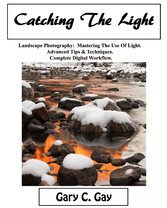Suchen und Finden
Service
Catching the Light - Landscape Photography: Mastering the Use of Light
Gary C. Gay
Verlag BookBaby, 2018
ISBN 9781543937268 , 285 Seiten
Format ePUB
Kopierschutz frei
29
29
29
Catching The Light
The biggest advantages of digital photography over film is the instant feedback you have when taking photographs. Your camera
LED screen and the information histogram help you know after clicking the shutter that you have the best exposure to capture all the details of any scene under any light condition.
To do this every time you take a photography you will need to work with your camera and learn where the meter normal exposure point is, and also how bright the image LED screen is in comparison to the meters average. To do this take a series of photos under different lighting conditions. Set the camera to manual and keep the exposure meter pointed at the center or average. Study each exposure, to see how bright the images appear on the LED screen.
Import this series of average exposed images into a computer system with a calibrated monitor. Study each images to find how far off
the camera meter is too learn where you will base your starting exposure. This point will also be based on your preference of how light or how dark you want the finished image.
This is the time to remember how bright the camera LED screen was compared to the new base exposure point. The LED screen gives you a picture based on a Jpeg produced by the cameras software, and not from the full information of a raw file.
The Fuji FinePixS2 Pro was my first digital SLR camera and I quickly learned not to use the LED screen to judge the camera exposure. Images would look perfect on the LED screen but then be up to a full stop under exposed in Photoshop.
I have found that both Nikon and Canon cameras shoot toward the darker range since if you have the choice to underexpose or
overexpose a digital file then the best to choice is to underexposed them.
Why? It nearly impossible to bring back an overexposed image with no detail in the highlight area. Where with software you can bright-en up and underexposed images to a point where it can be printed.
You need to learn to base all exposure on the histogram and understand the highlight warning option, only then can you produce
correct Raw exposure every time you snap the shutter.
One of my set rules is to only work in Camera Raw using the camera highest resolution to produce the best quality images.
With the evaluation of my technical experience. I’ve learned that the Raw file is superior. Now I only work in the Raw format.
Note: The Fuji FinePixS2 Pro, Fuji FinePixS3 Pro were based on the Nikon F- compatible camera body, but Fuji made a modification in theunique Super CCD sensor that uses low-sensitivity R-pixels and High Sensitivity S-pixels. I photograph in Jpeg when Frank E. Cricchio showed 30 x 40 inch prints shoot in Jpeg and processed in Photoshop from Fuji FinePixS2 Pro camera files.
The digital camera gives...



